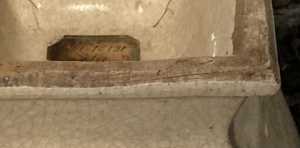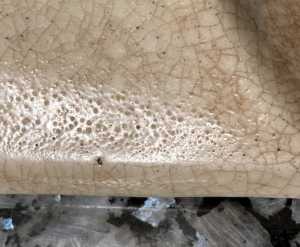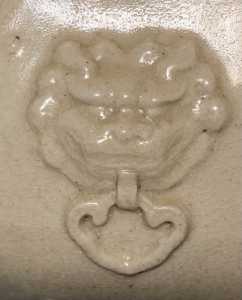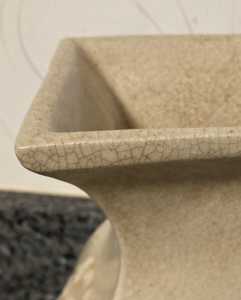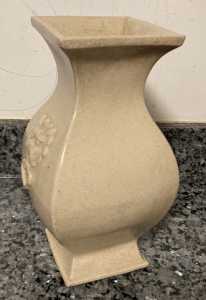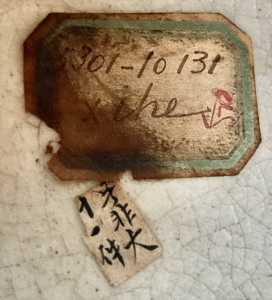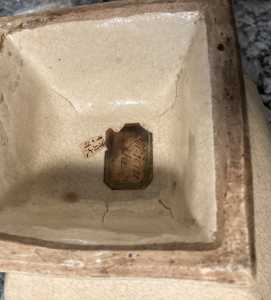The Chinese and Asian Art Forum. For Fans, Collectors and Dealers.
 Basic Rules For the BidAmount Asian Art Forum: Talk about whatever you want. You can even discuss and offer things that are for sale if they are authentic. Maximum image file size per post is 2 MB. Images of 700pxl x 700pxl are optimal if saved at a medium resolution. Be respectful of others and enjoy yourself. Click the YouTube link for a brief tutorial on using the forum. You can also EMBED Videos by cutting and pasting from You-Tube, Vimeo etc.
Basic Rules For the BidAmount Asian Art Forum: Talk about whatever you want. You can even discuss and offer things that are for sale if they are authentic. Maximum image file size per post is 2 MB. Images of 700pxl x 700pxl are optimal if saved at a medium resolution. Be respectful of others and enjoy yourself. Click the YouTube link for a brief tutorial on using the forum. You can also EMBED Videos by cutting and pasting from You-Tube, Vimeo etc.
NOTE: To post an item or add a new post, click open the category title from the FORUM LIST, and CLICK the Blue ADD TOPIC button.
Any thoughts on the age of this vase? It has an old label with a catalog number and the word ‘XIHE’ written in fountain pen.
The handles are unlike late Qing handles that depict a friendly ‘foo dog’, but rather a ferocious Buddhist lion.
The glaze is thick and pitted, foot rim is extremely deep, and the paste is stoneware-like, but definitely porcelain.
My thinking is that if it was catalogued as an antique in the 19th c., then it must have been at least 100 years old at the time the label was made (or at least thought to be that old).
There’s also a small label with 6 characters in kanji script. Can anyone recognize this mark?
It was sold to me as 19th c. I think it looks quite a bit older.
Not able to help on the vase but that label looks 1840's-1860's to me, and I suspect it wouldn't have been put on a new piece.
Though that foot rim and the way it is trimmed really does look to have age, I just do not know these wares at all.
Jeremy
@jbeer2121 Hiw did you come up with the date on the use of this type of label?
I’m coming up with very little on finding anything similar, but this type of Buddhist lion handles seem to have been used in Dehua vases from the 17th c.
https://www.dia.org/art/collection/object/sleeve-vase-two-molded-lion-head-handles-37555
I will hunt for the pictures I may still have on my computer when I get home, but I have dealt with a lot paintings from Europe, 16th through 19th century, and that style of bordered label really fits with what I have seen in that time period. Also I will say the foot reminds me of some mid 17th century pieces, I just cannot find anything comparable.
Jeremy
@jbeer2121 That would be great if you’re able to find some photos.
I just found this crackle green vase - Kangxi period. Good provenance and reputable dealer.
Notice how shallow the foot is on the Kangxi example, and how the lion handles are a bit more Qing -like.
https://www.johnmoran.com/auction-lot/a-chinese-apple-green-crackle-glaze-fanghu-vase_C9743D9AFD
I have seen the lion mask on allegedly Ming pieces but also on much more recent ones. I have some on a vase, which I am convinced is mid-20th c PROC.
The label does look old, but is there anyway you can tell it has been re-used from something else? I am not saying it has, just eliminating possibilities. If I were shown the base, I would guess at it being 19th c.
@julia I think any attempt to transfer the label would have resulted in cracking or creases, so I’m sure it was not transferred.
I would be interested in seeing any example of Qing wares that have this type of deep foot and/or handles if you have some photos.
According to the style and glaze I think it's from Shiwan kiln, late Qing period.
www.Wyssemaria-Art.com
[email protected]
Instagram: @wyssemaria_art
@xin_fawis Thank you! Yes, Shiwan kiln wares match up well, but I can’t find photos is the bottoms. That deep foot is unusual for Qing period wares.
The archaic examples I find all seem to be 17th c., and 19th c. examples I see are green glazed pottery.
Is there anything to learn from the labels? Could you translate the 6 characters?
Thanks!
It’s definitely porcelain, not pottery. Does that disqualify Shiwan wares?
It also could be something from Fujian local kilns. Really hard to identify the paste without handling in this case.
The label is kind of inventory label, it reads "number not big (size or type) eleven". It's an old way of categorization.
www.Wyssemaria-Art.com
[email protected]
Instagram: @wyssemaria_art
@xin_fawis Thank you!
So, I’m looking through examples held by the Smithsonian museum.
This one is similar in glaze and the use of relief decoration, but no photo of the base. However, the deep foot might be unique to fanghu shapes (although Qing examples still seem to not have deep foots).
Here’s one that sold and shows the foot. The paste does look very similar.
https://www.liveauctioneers.com/item/10806540_76-a-rare-ming-dynasty-shiwan-stoneware-vase-17th-cen
Tim, you are right, I can’t find anything with the deep foot except on older, usually metal, examples. Neither can I find a late qing vase of this shape with those handles. If I do, I will let you know.
Hello @greeno107,
Think your vase originates from South China. There are several similar vase's illustrated in Shiwan Ceramics Beauty color and passion published by the Chinese culture foundation of San Francisco. The Buddhist Lion handles with the large molded in ring is a common feature. They all mostly made in the form of ancient bronze prototypes They have very similar base's to your vase. The body of the ceramic is a slightly gritty highly fired stoneware. It is fired at a high enough temperate that the body has almost vitrified to the point it can feel like porcelain. According the the book mentioned above your vase is glazed in what is called Moon white crackle. This glaze has been in use since the Ming dynasty it has however been used in later periods. These type of wares were made over quite a large area in South China so attributing to a particular kiln can be very difficult, but guess it's safe to say Shiwan type. The body type and firing method did not change until the 20thc so it is safe to say your vase is not a modern copy but as the methods did not change for such a long time distinguishing between the Ming and Qing is very difficult and would require a lot of experience and study.
Cheers
Michael
Thanks for visiting "The BidAmount Asian Art Forum | Chinese Art"
If you sell on eBay, or have a shop feel free to post images and descriptions and links.
Check back often for discussion about the latest news in the Chinese art and antique world. Also find out about the latest Asian art auctions at Sotheby's, Christie's, Bonhams and Tajans.
Auction results for: fine porcelain, ceramics, bronze, jade, textiles and scholar's objects. As well as Japanese, Thai, Vietnamese and other Asian cultures.
Thank you,
Peter Combs
Topics and categories on The BidAmount Asian Art Forum | Chinese Art
Kangxi vases, Kangxi dishes and chargers, Kangxi ritual pieces, Kangxi scholar's objects, Qianlong famille rose, Qianlong enamels, Qianlong period paintings, Qianlong Emporer's court, Fine porcelain of the Yongzheng period. Chinese imperial art, Ming porcelain including Jiajing, Wanli, Xuande, Chenghua as well as Ming jades and bronzes.
The BidAmount Asian Art Forum | Chinese Art
A free Asian art discussion board and Asian art message board for dealers and collectors of art and antiques from China, Japan, Korea, Thailand, Cambodia, Vietnam and the rest of Asia. Linked to all of the BidAmount Asian art reference areas, with videos from plcombs Asian Art and Bidamount on YouTube. Sign up also for the weekly BidAmount newsletter and catalogs of active eBay listing of Chinese porcelain, bronze, jades, robes, and paintings.
The art of calligraphy - and for the ancient Chinese it certainly was an art - aimed to demonstrate superior control and skill using brush and ink. Calligraphy established itself as one of the major Chinese art forms during the Han dynasty (206 BCE - 220 CE), and for two millennia after, all educated men were expected to be proficient at it.
The Museum’s collections of Asian art span nearly five millennia and encompass the cultures of China, the Himalayas, India, Japan, Korea, and Southeast Asia. In 2007, the Museum launched an initiative to create dedicated galleries for the collection, beginning with a gallery for the arts of Korea ...
Chinese art is full of symbolism, in that artists typically seek to depict some aspect of a totality of which they are intuitively aware.
China Online Museum is the finest online museum of Chinese art. It features Chinese calligraphy, painting, ceramics, bronzes, carving, and other artworks.
Chinese Ceramics & Works of Art. Overview Upcoming auctions Contacts Auction results ... Christie’s sales of Chinese ceramics and works of art showcase centuries of Chinese history. Held throughout the year in London, New York, Paris and Hong Kong, they attract a wide audience of collectors and connoisseurs vying for pieces as diverse as ...
Explore Asian Art Week. Contact the Specialist Department. Chinese Paintings ... Senior Specialist, Head of Sale. [email protected]. Tel:+1 212 641 5760. Bid in-person or online for the upcoming auction:Fine Chinese Paintings on 10 September 2019 at New York. Bid in-person or online for the upcoming auction:Fine Chinese Paintings on 10 ...
Discover an abundance of must-see art from all corners of a vast continent at Christie’s NY Asian Art Week. From contemporary classical and Chinese paintings to works with exemplary provenance from the Art Institute of Chicago, our Rockefeller Paza galleries will be full of ancient treasures and contemporary masterworks in a salute to the vibrant arts of Asia.
Sold to benefit The Art Institute of Chicago’s Asian Art Acquisition Fund, the sale features 84 lots with a focus on Ming and Qing porcelains, and offers a rare insight into the taste for collecting Chinese ceramics and works of art in the Midwest from the end of the 19th century through the 1980s. Highlights include two Wanli wucai garlic-head vases, a Qianlong mark and period, blue and ...
Specialist, Chinese Paintings, Christie's London Dr Malcolm McNeill is a Specialist in Chinese Paintings at Christie’s, based in London. He previously worked as an assistant curator of the Chinese collections and the Victoria and Albert Museum in London, as a researcher at the British Museum, and as a translator and tour guide at the National Palace Museum in Taipei.
The Christie's Education 2020 Conference: The Chinese Art Market 18 Jun 2019 Christie’s Education is delighted to announce our first international academic conference in Asia which will take place in Hong Kong from 26-27 November 2020 at the Hong Kong Convention and Exhibition Centre and will run in parallel with Christie’s Hong Kong Autumn Auctions.
The summer Chinese Art sale in Hong Kong will feature works of art from several private collections, including Qing porcelains and textile from the collection of the legendary Chinese art dealer A. W. Bahr (1877–1959), fine gilt bronze Buddhist sculptures from an old Hong Kong collection, an East Asian collection of Qing dynasty wine cups and jades, and a Japanese collection of Song ceramics ...
Sotheby's Chinese Works of Art Department holds two auctions each year in London, New York, Hong Kong and Paris.
Chinese Art - View Auction details, bid, buy and collect the various artworks at Sothebys Art Auction House.
With more than 340 Chinese works of art dating from the Neolithic to the Republic periods, highlights of this sale include a selection of Qing Imperial monochromes from the collection of Arnold and Blema Steinberg, early ceramics from the Art Institute of Chicago and Chinese porcelain and works of art from the collection of Henry Arnhold.
Results: Sotheby's Asia Week achieved $52.4 million in six strong auctions, exceeding pre-sale estimates. With 76.5% of lots sold and 60.3% of lots surpassing high estimates, the Asian art sales at Sotheby's indicate continued collector interest in the finest works of art from China, India and and the Himalayas.
Today's sale of Important Chinese Art will proceed as planned with sessions at 10 AM and 2 PM EDT. Sotheby's will be monitoring the weather conditions throughout the day and will be available to coordinate alternative bidding options should conditions make it difficult for clients to attend the auction in person.
Bonhams Chinese Art department is renowned for offering the finest works of art representing the richness and breadth of China's artistic heritage, particularly Imperial porcelain, white and spinach green jades, cloisonné and Buddhist art. Specialised international auctions are held globally, including London, Hong Kong and San Francisco.
Bonhams : Chinese Works of Art We use cookies to remember choices you make on functionality and personal features to enhance your experience to our site. By continuing to use our site you consent to the use of cookies. Please refer to our privacy and cookie policies for more information.
Bonhams Fine Art Auctioneers & Valuers: auctioneers of art, pictures, collectables and motor cars. We use cookies to remember choices you make on functionality and personal features to enhance your experience to our site. By continuing to use our site you consent to the use of cookies. ... Chinese Art (US) General enquiries
Bonhams : Fine Chinese Art We use cookies to remember choices you make on functionality and personal features to enhance your experience to our site. By continuing to use our site you consent to the use of cookies. Please refer to our privacy and cookie policies for more information.
Bonhams Fine Art Auctioneers & Valuers: auctioneers of art, pictures, collectables and motor cars Bonhams : Asian Art We use cookies to remember choices you make on functionality and personal features to enhance your experience to our site.
Bonhams are international auctioneers of fine Chinese and Japanese art. We specialise in rare Imperial and Export Chinese ceramics and works of art, as well as Japanese ceramics, fine and decorative works of art from the Neolithic Period to the 20th century. View on map
Bonhams Fine Art Auctioneers & Valuers: auctioneers of art, pictures, collectables and motor cars. We use cookies to remember choices you make on functionality and personal features to enhance your experience to our site. By continuing to use our site you consent to the use of cookies. ... Asian Art Bonhams. Work. 22 Queen St.
